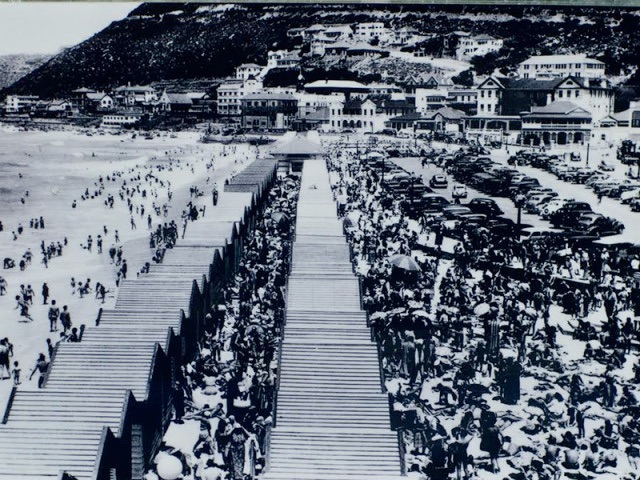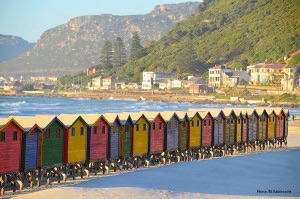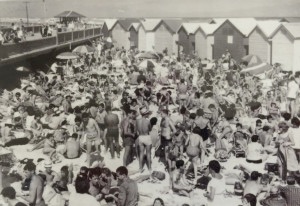Muizenberg, South Africa
EXHIBIT RECALLS SOUTH AFRICA’S ‘SHTETL BY THE SEA’
By Jodie Shupac, Staff Reporter
Reposted from
CJN Canadian Jewish News
November 10, 2015
Original article CJN:
cjnews.com/news/canada/exhibit-recalls-south-africas-shtetl-by-the-sea
Muizenberg
Dubbed by some “the shtetl by the sea,” North American Jews might best understand Muizenberg, a beachside suburb of Cape Town once brimming with both Jewish residents and Jewish holiday-goers, as the Miami of South Africa.
Memories of Muizenberg, a South African exhibition featuring photographs and recollections from the post-World War II hub of Jewish life and culture, will be showcased Nov. 16 to 29 at Toronto’s Schwartz/Reisman Centre, marking the show’s 10th international appearance.
Most recently shown in various cities in Australia, the exhibit, curated by Johannseburg-based Joy Kropman, was brought to Toronto by Richard Stern, 78, a Torontonian who himself grew up along the beach in Muizenberg.
Eli Rabinowitz, who organized the exhibit in Australia, was, Stern said, “instrumental in organizing for the exhibit to come to Canada. Without his guidance and support, it would have been difficult to achieve this.”
Bathing boxes at Muizenberg ELI RABINOWITZ PHOTO
He said the exhibit features about 40 panels displaying memorabilia – mainly images and accompanying text – from what was considered a kind of golden age for Jews in Muizenberg, as well as more than 1,000 photographs submitted by Jews who had lived or vacationed in the town during its Jewish heyday, roughly between 1950 and 1965.
Stern, who moved to Canada in 1963, explained that in this period, anywhere from 10,000 to 20,000 Jews would regularly travel to Muizenberg to escape the heat of the South African interior and relax by the sea during the country’s summer months of December and January.
In addition, at the peak of the town’s popularity among South African Jews, about 600 Jewish families made Muizenberg their permanent residence, and the town had both a synagogue and kosher hotels.
“That beach used to be absolutely packed during summer months. There were thousands of young people. The older people would sit by the seaside and the younger people would be by what was called the ‘snake pit’ – a protected area, a piece of sand with bathing boxes on one side and a pavilion on the other that people packed into from one corner to another,” Stern recalled.
“Muizenberg was very much a part of people’s lives growing up. Many Jews met their spouses there,” he added.
After Stern’s brother, who lives in Israel, made the opening speech for the exhibit’s Herzliya stop, Stern said he inquired about bringing Memories of Muizenberg to Toronto, and he ultimately paid to ship the exhibit here.
“They were going to destroy it, because after Australia, no one else wanted to take the exhibit. I thought it would be a good community project, as so many South African Jews live here in Canada… It’s a real walk down memory lane,” he said.
He noted that many Jews hailing from Muizenberg became quite influential, starting large companies in South Africa.
“The whole of the beachfront was settled by mining magnates like the Oppenheimer family and the Schlesinger family. All the houses along the beachfront were designed by Sir Herbert Baker, an architect who designed the Union Buildings in Pretoria,” he said.
Muizenberg during its heyday
Stern’s own grandfather, Max Sonnenberg, moved from Germany to Muizenberg and later became a member of parliament in South Africa during World War II.
Due to political upheaval in South Africa from the mid-1960s to the 1980s, the country’s Jewish population dwindled substantially, and a large number of Jews who had either lived or vacationed in Muizenberg moved to Canada.
Stern, whose four grandparents hailed, respectively, from Germany, England and the United States before ending up in Muizenberg, said the exhibit’s illustrative panels give viewers who are unfamiliar with the seaside town a real sense of what Jewish life was like there.
And for those who are actually from Muizenberg or who spent their summer vacations there, the exhibit will be an opportunity to reminisce and recognize people they once knew in the many photographs.
After Toronto, Stern said, the exhibit will head to San Diego, and then, possibly, to Dallas.
-
•TAGS
This article appears in the latest issue of the Canadian Jewish News
cjnews.com/news/canada/exhibit-recalls-south-africas-shtetl-by-the-sea
Also on the Muizenberg KehilaLink

Opened by Stephen Pincus
Schwartz - Reisman Centre
Vaughan ON
Toronto Canada
16 -19 November 2015
‘Memories of Muizenberg 1900-1965’
Exhibiting the brief summer of South African Jewry

bronzed teenaged bodies jostling for space - and attention - in the snake pit
buxom Jewish matrons ambling along the Promenade to take in the “Luft”
and fortify themselves for the coming year on the Highveld
fathers and sons – and mothers and daughters - body surfing together in the turquoise waves
- and then racing across the soft white sand
children cranking the handles of the “penny machines” at the grand Pavilion,
then eating ice lollies as they compare their “blue bottle” scars
After half a century, why are these images still so powerful for anyone who experienced a Muizenberg holiday?
And what deep emotional forces catalyzed this wonderful exhibition and propelled it across the world – from South Africa to Israel to England to Australia and now to Canada and the United States?
Joy Kropman, the curator of the exhibition observed that in true “Litvak” tradition, such an exhibition would not be complete without a “faribal”. She related the following story: an old black-and-white photo of a tall pretty girl in a one-piece bathing suit nearly led to the Second Battle of Muizenberg - you may recall that the first was in 1795. At the opening of the exhibition in Cape Town, a jealous 80 year old lady noticed that this photo was selected rather than the photo of herself in a more sexy two-piece. “Who is that?” She ranted. “I was a lot prettier than her.”
In London, the Memories of Muizenberg exhibition was opened by Sir Jeremy Isaacs, the famous British TV producer of the World at War, who married a Muizenberg girl. He commented that it “offers a portrait of a thriving community - working hard, playing hard, happy with themselves, happy in their skins…” But he goes on to say that he has “never met a group of exiles who hammer on so relentlessly about their past and their nostalgia as the former inhabitants of Muizenberg - the mountain, the beach, the luft, the people - human and friendly, weird and eccentric - in their minds they remain in the centre of the universe.”
One family at the centre of Muizenberg life was the Sterns. Richard’s parents Tillie and Bertie Stern were known as Arkela and Sandpiper. Their legacy to Muizenberg still stands – the Masque Theatre of which Richard is a trustee.
Bertie was the iconic “Sandpiper Stern” who ran the Habonim Camp with a firm hand in the 1940s and 1950s. When we were planning Habonim’s Golden Jubilee Dinner in 1980, I visited the Stern’s beautiful old home in Muizenberg, right opposite the beachfront, to invite Sandpiper as the surprise guest. Although he had no contact with Habonim for decades, he agreed to attend the dinner, and when 1000 people had taken their seats in the ballroom, we switched off the lights.
When we turned the lights back on, in marched Sandpiper Stern. By then he was an elderly man - but he still had a ramrod back and was dressed in full Habonim uniform - complete with khaki shorts, scarf and woggle, and wooden truncheon - blowing his police whistle. The room broke out into pandemonium.
In a very real sense, tonight’s event - and the very presence of this exhibition in Toronto, is testimony to the values of the Stern family, shaped - no doubt – by their Muizenberg environment: generosity, commitment to community, respect for tradition, and fastidious organizational discipline. Richard Stern exemplifies these values. He is not only responsible for bringing the exhibition to Toronto, but for ensuring that every detail has been planned and executed to perfection.
Habonim Camp and Muizenberg were two of the great formative holiday experiences of a South African Jewish upbringing.
The well-known Canadian broadcaster, Isme Bennie, compared these holiday experiences. She wrote: “…I walked for miles along the beach looking for a snake park. I did not realize that it was the name for a crowded triangle of beach, edged by a row of bathing huts on one side and the concrete wall of a promenade on another, where all the young people hung out. The air in Muizenberg was invigorating, full of saline, and the sea had breakers to jump into or surf upon. One could stay in for hours. But the Snake Park had the attraction that it brought girls and guys with hopes for a date, or at least a few weeks’ vacation relationship, into close quarters…
Then I went to Habonim camp one summer. If the Muizenberg experience was inadequate for my mother, so was camp for me. There were six of us to a tent we had to put up ourselves. We slept on bedrolls. If it rained, we got soaked. We had to help with food prep at the large communal kitchen. Showers and toilets were a long walk away. Even accessing the beach for a daily swim was preceded by a trek through brush. ..I came home very grubby and with a strep throat.” [You can find more of that in Bennie’s story George or Holidays by the Sea]
This past summer, I was involved with a short pilot program in Israel for ex-Southern Africans with some Habonim connection. For many participants, the program - called “Dreamers” – was quite transformative, seeking to re-create that special experience of feeling young again; and certainly there was a healthy amount of nostalgia involved, as there is in the Muizenberg exhibition.
Nostalgia was once thought of as a disease, but psychological studies have shown that – to quote one – “it bolsters social bonds, increases self-regard, and generates positive affect.” One expert comments: “Nostalgia serves a crucial existential function, bringing to mind cherished experiences that assure us we are valued people who have meaningful lives.”
In the words of Simon and Garfunkel, as you might have heard them on the Muizenberg promenade in the late 1960s or 70s coming from an eight track tape recorder on a breezy moonlit night: “A time it was, and what a time it was, it was - A time of innocence - A time of confidences.”
In short, for many of us this exhibition recaptures a very powerful sense of being young, and of going back home. Perhaps more than home – because Muizenberg was a home away from home – a place of romance, of rest and restoration.
And, like the Dreamers program, perhaps Memories of Muizenberg has the potential to take us beyond our nostalgic longing for our lost youth.
After all, those formative summer experiences long ago at the tip of Africa nurtured the personalities, the values, and the confidences, that have enabled us to create - on these colder, quite different shores - families, careers, communities and legacies that are strong, rich in their diversity, and enduring.
As for the Muizenberg of today, it is of course a quite different place, in a very different South Africa. Certainly we can be thankful the trappings of apartheid that make us cringe have disappeared.
So as we look at the Muizenberg of then, we can embrace what we once experienced there - and what it has become - with a sense of satisfaction rather than of loss.
Opening speech given by Stephen Pincus
A profoundly impactful exhibition, remembering the golden days of the Jewish families who lived in, and those who flocked to Muizenberg in the summer holidays, in the first half of the 20th century, opened at the South African Jewish Museum (SAJM) in Cape Town in March 2010. The brainchild of curator Joy Kropman – this exhibition evoked such powerful nostalgia that South African Ex-Pats all around the world made extraordinary efforts for it to be seen in their new abodes.
After an exceptional run in Cape Town, the exhibition moved to Muizenberg itself, at the Countess Labia Museum and then to Johannesburg. Next it went overseas. In 2012 it was shown at Beth Protea in Herzlia. Israel. In May 2013 it was opened at the London Jewish Cultural Centre in London by Sir Jeremy Isaacs. In December 2013, the exhibition opened at the Central Community Centre in Melbourne before opening at the Bnai Brith centre in Sydney in February 2014 and at Chabad WA in Perth in April. For each of its moves an ex-South African Jew ‘adopted’ the exhibition, gathering fundraisers, assistants and spaces in their respective cities for the 40-panel exhibition. By August 2014 it was back in Sydney – this time at the North Shore Synagogue in Lindfield. Eli Rabinowitz, who had facilitated the exhibitions in Australia, guided and supported Canadians to mount the exhibition in Toronto. Next it opened at the ‘Cape Town Grill’ in Dan Deigo in March 2016. In July 2016 it was trucked to Vancouver where it opened at the Congregation Beth Israel.






